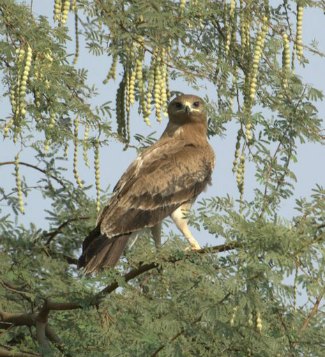Indian Spotted Eagle - Aquila hastata
Family: Accipitridae
Genus: Aquila
Species: A. hastata
Indian Spotted Eagles are medium-sized, brown eagles that occur in Pakistan, India, and parts of Southeast Asia. They used to be classified as part of Aquila pomarina (Lesser Spotted Eagle) but the two have been split into separate species based on differences in morphology, behavior, clutch size, and osteology. Indian Spotted Eagles also form a monophylum with Aquila clanga (Greater Spotted Eagle), A. pomarina (Lesser Spotted Eagle), and Lophaetus occipitalis (Long-Crested Eagle).
Physical Description:
Indian Spotted Eagles are entirely brown with contrasting wing coverts and flight feathers. The gape-flange—the fleshy area where the mandibles meet—is large and extends out to the center of the eye. The wings and tail are short, and the head is large relative to body size.
Their call is a high-pitched cackle.
Size:
Length: 65 cm
Wingspan: 154-168 cm
Habitat and Distribution:
They live in wetlands, open forest, forest clearings, and cultivated areas. They are fairly tame and have been observed perching in paddyfields and even urban parks.
Their range spans from Pakistan, northern India, and Bhutan to Bangladesh, Myanmar, and Cambodia. Indian Spotted Eagles are non-migratory. There are approximately 2,500-9,999 individuals across 1,260,000 km².
Diet and Hunting:
Most of their diet is mammals, which are caught on the ground. They also eat frogs and birds.
Reproduction:
Breeding displays consist of "wing-winnowing" (where the wings are raised at a sharp angle), "heart dives" (which is when they pull back their wings into a so-called heart shape), and looping flight. The breeding season is from March-May.
The nest is a flat platform placed in the fork of a tree. It is built mainly by the female, though males will sometimes bring sticks to the nest site. Clutch size is 1-2 eggs, usually 1, and both the female and the male incubate it for at least 31 days. Fledging takes around 71 days.
Conservation:
Indian Spotted Eagles are currently listed as Vulnerable by BirdLife International due to a small, declining population. The cause of the drop in numbers is, at least in part, habitat conversion; more research is needed to determine other factors and the exact rate of decline.
Taxonomy:
Aquila hastata and Aquila pomarina (Lesser Spotted Eagle) were formerly treated as a single species until evidence based on morphology, behavior, clutch size, and osteology indicated that they should be considered separate. This theory was further supported by studies done on their mitochondrial DNA that showed A. hastata was more distant genetically from A. pomarina than A. pomarina was from the completely separate species A. clanga (Greater Spotted Eagle).
Molecular studies have also indicated that A. clanga, A. pomarina, and A. hastata form a monophylum with Lophaetus occipitalis (Long-Crested Eagle). It has been proposed that spotted eagles be merged into the genus Lophaetus, but because classification is still uncertain and under debate, Indian Spotted Eagles are referred to as Aquila hastata on this website.
Other Names:
Long-Legged Eagle, Small Indian Spotted Eagle, Orel indický (Czech), Indisk Skrigeørn (Danish), Indische Gevlekte Arend (Dutch), Lõuna-konnakotkas (Estonian), Aigle lancéolé (French), Schreiadler-hastata (German), Aquila anatraia minore (Italian), Indowashi (Japanese), Indiaskrikørn (Norwegian), Orlik induski (Polish), Águila Moteada Hindú (Spanish), Indisk skriörn (Swedish).
Other Multimedia:
None available.
References:
http://avibase.bsc-eoc.org/species.jsp?avibaseid=3A985C9F51F9CACE
BirdLife International (2011) Species factsheet: Aquila hastata. Downloaded from http://www.birdlife.org on 22/12/2011.
Global Raptor Information Network. 2011. Species account: Indian Spotted Eagle Lophaetus hastatus. Downloaded from
http://www.globalraptors.org on 22 Dec. 2011
BirdLife International 2008. Aquila hastata. In: IUCN 2011. IUCN Red List of Threatened Species. Version 2011.2.
www.iucnredlist.org. Downloaded on 22 December 2011.
http://www.planetofbirds.com/accipitriformes-accipitridae-indian-spotted-eagle-aquila-hastata
